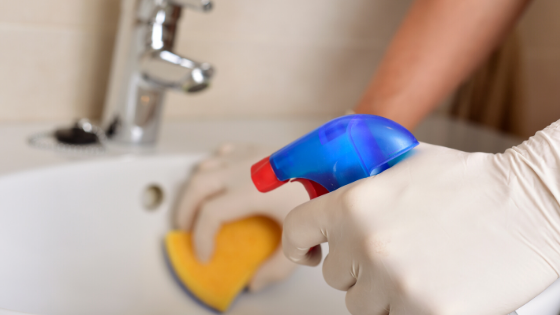 The EPA and other organizations issue regular updates on disinfectant chemicals tailored to current public health situations. Of all of the various disinfectants available, however, the one most accessible in any period of shortage is often common household bleach.
The EPA and other organizations issue regular updates on disinfectant chemicals tailored to current public health situations. Of all of the various disinfectants available, however, the one most accessible in any period of shortage is often common household bleach.
Bleach has several advantages as a practical cleaning and disinfecting agent:
- It is available in quantity at many commercial and industrial workspaces
- It is relatively inexpensive and tends to be easy to procure and replenish
- It is effective for common disinfecting tasks when diluted substantially
- Its basic usage and general safety precautions are familiar to most adults
With that in mind, disinfecting your work area with bleach is often a wise decision when other commercial disinfectants cannot be obtained. Bleach is capable of reducing the number of many common microbes on work surfaces, not only cleaning contaminants from the surface.
Although bleach does not kill all germs, it has a broad spectrum of effects recognized around the world. International industrial organizations continue to use bleach in a wide range of daily applications. Bacteria, fungi, and viruses can all be eliminated by bleach within a short time.
For all these reasons, bleach is even commonly used as a disinfectant at healthcare facilities.
Preparations Before Using Bleach for Workplace Disinfecting
Barring ingestion, the most significant risks around the use of bleach are irritation of the skin, mucous membranes, and airways. The fumes from bleach can be powerful enough to cause significant irritation to the eyes, with damage occurring from relatively mild exposure.
Before starting on a disinfecting project using bleach, ensure the following:
1. PPE is Available and Being Used Correctly
Common industrial PPE does an excellent job of protecting you while using bleach. The use of a mask, gloves, and waterproof apron is recommended. Where available, it is also a good idea to wear goggles – especially if you will be preparing a diluted bleach mixture.
2. Adequate Ventilation is Available
Undiluted bleach is corrosive and emits toxic gas when exposed to sunlight. The process of air drying a bleached surface presents safety risks, especially in enclosed spaces. Still, air drying is often preferred because transferring bleach to cloth can result in a fire hazard. Windows and doors should be open when possible and HVAC settings optimized for maximum airflow.
3. Contact Time Will Be Sufficient
Although bleach is very powerful, its disinfectant qualities do not activate instantly. It is vital for bleach to be in contact with the surface for at least ten full minutes. The maximum effect is usually achieved after the 50-minute mark. Use your own knowledge of the workplace and judgment to determine whether a longer exposure period makes sense in your situation.
4. Others Are Aware of the Hazard
Make others in your workplace aware of your disinfecting plans if these tasks are not part of your regular operational schedule. Colleagues may need to avoid the area for the duration, which often means reorganizing work tasks. The sooner you communicate your plans, the better.
5. Diluted Bleach Solution is Ready
The great majority of disinfection work is performed using diluted bleach. The Department of Homeland Security recommends a dilution ratio of one tablespoon of bleach to four cups of water. The bleach solution should be prepared fresh daily, so factor the time needed into your plans. Do not combine bleach with ammonia or any other type of cleaner.
Key Precautions for the Use of Bleach in Professional Environments
Surfaces should be cleaned with warm water to remove surface contaminants before bleach is applied. The combination of cleaning and disinfecting is most likely to produce the greatest anti-microbial result. Some organic materials can inactivate bleach, making cleaning a necessity.
When applying bleach, always adhere to these guidelines:
- Do not use bleach on any metal or painted surfaces that may be damaged by it
- Avoid touching the eyes, and rinse with water right away if eye contact occurs
- To maximize disinfectant power, use bleach that has been produced recently
- Keep diluted bleach in a dark container, covered, and protected from sunlight
Bleach and Coating Performance in the Workplace
From a facilities standpoint, the greatest drawback of using bleach is its potential to damage some surfaces. Bleach should never be applied to copper or stainless steel. In many industrial environments, of course, stainless steel is abundant and incidental contact can occur.
Painted substrates are especially vulnerable to damage caused by bleach. One way to reduce exposure while maintaining superior disinfection rates is to use antimicrobial coatings: Sherwin-Williams Paint Shield is currently the only truly microbicidal coating approved by the EPA.
Using Paint Shield in your commercial painting projects helps you ensure surfaces that may require specialized cleaning agents are less likely to spread infection. It will also assist you in streamlining maintenance and improving the overall longevity of your painted substrates.
{{cta(‘9356bbf0-d14e-480d-988b-2427a4af661a’)}}






